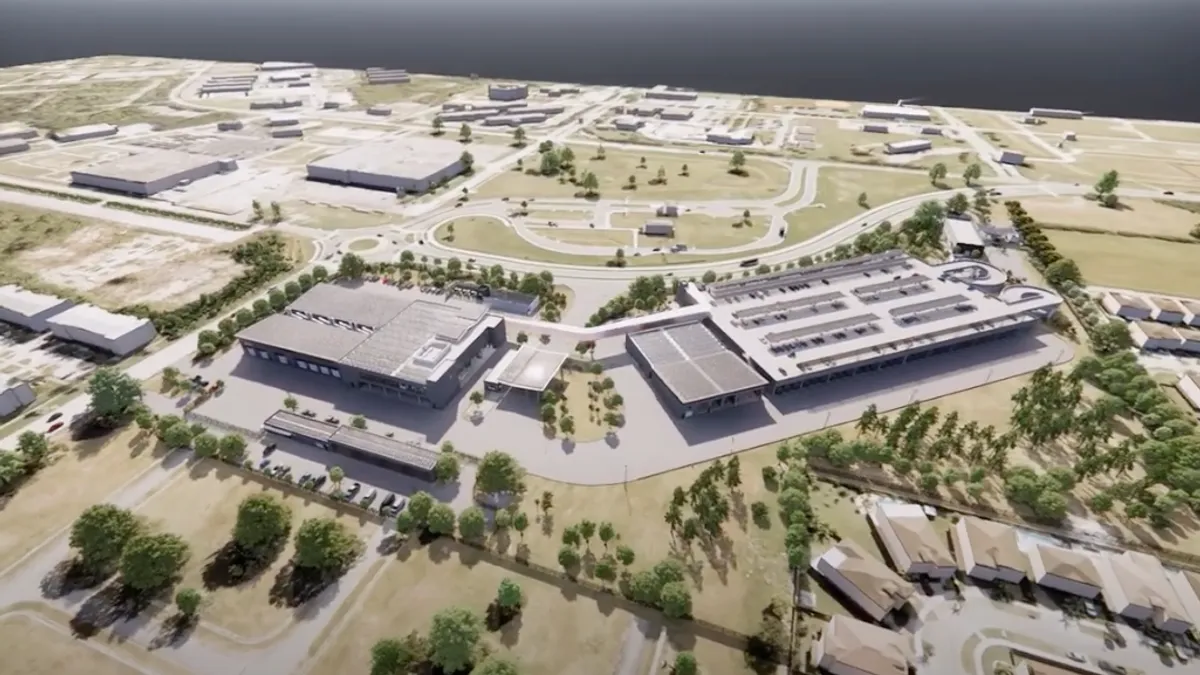Miami-Dade County is on a tight timeline to build what could be the “most innovative and largest all-electric bus maintenance and transit operations center in the country,” says Eulois Cleckley, director and CEO of the county’s department of transportation and public works.
Work on the South Dade Transit Operations Center broke ground June 25 on a 20-acre site that will include charging stations, maintenance facilities, driver training, bus dispatching and an emergency command center for the Miami-Dade County Department of Transportation and Public Works. The facility will also provide for solar power and a water reclamation system for bus washing.
Workers have 90 days to build one of the first pieces of the all-new bus operations and maintenance center in South Florida: a utility vault to serve a new fleet of 100 60-foot articulated battery-electric buses for Miami-Dade County. Construction is on schedule, assured Angel André Chavarria, senior vice president and alternative delivery project director at WSP, in a recent interview.
The county currently has 800 buses and set a goal of electrifying 20% of its fleet, Cleckley said. The fleet already includes 69 40-foot electric buses, built by Proterra, which declared bankruptcy in 2023. Cleckley said the fleet of 100 articulated buses will come from New Flyer, which has an almost $12 billion backlog in orders, partly as a result of Proterra and another competitor leaving the U.S. transit market. Two test buses are already on hand, Cleckley said.
Building a safe, resilient maintenance depot
Chavarria explained that charging the buses will require about 10 megawatts of available power, while five more MW are needed to run the rest of the facility. WSP has been working with Florida Power & Light since November 2022, he said. After the utility vault is finished, FPL will install, test and commission the necessary equipment.
The charging equipment will be located on the bus roofs. When the buses are parked for charging, retractable platforms will allow workers easy and safe access to the equipment, said Chavarria. But because lithium-ion batteries pose a fire hazard, the structure will be heat-insulated to prevent damage should a fire erupt, he said. Sprinklers will activate in an area just around the fire location rather than the entire building. “Given that it's a 100,000-square-foot facility, we can't have the entire building go off,” Chavarria said.
Since South Florida is prone to hurricanes, Chavarria said his firm did a sea-level rise analysis and designed the floor slab to sit well above the natural level of the land to mitigate climate hazards.
Benefits extend beyond the bus facility
The tight timeline gives contractors 300 days to complete the first phase of the project, Chavarria said. That’s because a new bus rapid transit route is scheduled to open before next summer. The new operations center will be home to the South Dade Transitway buses.
Miami-Dade’s first bus rapid transit line will cover a 20-mile corridor from the Dadeland South Metrorail station in Pinecrest, Florida, to Florida City, Florida. It will include 14 level-boarding stations for accessibility, traffic signal preemption to keep buses moving through intersections and gate arms with warning lights at intersections for added safety. The northern terminus connects with Miami-Dade’s Metrorail that serves downtown Miami and the Miami International Airport. “It's a significant time savings for this community,” Cleckley said.
Miami-Dade’s plans for the site go beyond the bus facility, which will employ 270 people when the second phase is completed in 2026, Cleckley said. The project also includes an entertainment center on an adjacent seven acres owned by the county. The entire effort is considered an economic development project, he explained: “The entertainment district we anticipate to provide not only entertainment, but also jobs that's needed in this community.”












